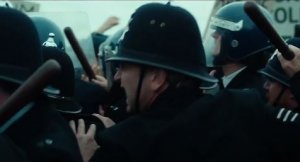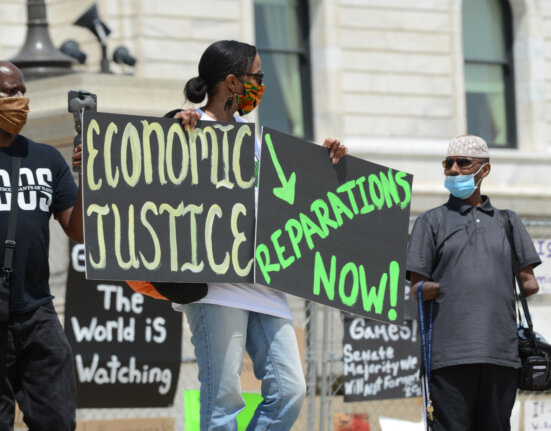Is there life after coal, what future for the collier?
The scab and the hardliner both, wear the blue scars of the miner
Rising up now from the earth, we’re branded and we’re blinded
The sunlight and the dole queue boast, the blue scars of the miner
Is there anything but drink, drugs and last reminders
A single tear drop rolling down, the blue scars of the miner
–Lyrics from the “Blue Scars of the Miner,” The Freakons, 2022.
As the camera floats over a dense forest at the start of Sherwood, the new BBC crime drama, the voice of Arthur Scargill, president of Great Britain’s National Union of Mineworkers (NUM), breaks through the rustling of the treetops. “And you’ve got to make up your mind,” insists Scargill during the momentous strike of 1984-85. “Are you going to accept it down on your knees, or are you going to stand and fight the closure and the butchery of your industry?” Next newsreel images of the infamous “Battle of Orgreave,” where police clashed with the “flying pickets” of the NUM, who had gathered outside a South Yorkshire Coking plant to prevent deliveries of coal. Margaret Thatcher, five years in as Tory Prime Minister, then gets her turn. “You saw the scenes on television last night,” she says at a press conference. “I must tell you, that what we’ve got, is an attempt to substitute the rule of the mob for the rule of law!”
The main battle lines thus drawn, the preface-by-news-clip focuses in on Nottinghamshire, a county tucked between Sheffield to the northwest, Leicestershire to the South, and Yorkshire to the Northeast. Home to a dozen plus coal pits in the early 1980s, “Notts,” along with Derbyshire and Leicestershire, saw a majority of its miners continue to work through the strike. Shots of working miners explaining their actions mix in with images of angry strikers calling them out. “We won’t be bullied by pickets from Yorkshire,” one of the former tells a reporter. Scargill gets the final word: those that crossed the picket line, he declares in a speech, “shall be stained till the end of time—as a scab!”
Memory and Murder
A six-part series written by playwright and native of Nottinghamshire James Graham, Sherwood is not about the Miners’ strike, formally speaking. Based loosely on two murders that took place in 2004 in the village where Graham grew up, it is, however, very much about the memory of the strike. In the murders of 2004, one of the victims was a former miner who struck and stayed out until the NUM’s defeat in 1985. The killer, who used a crossbow, turned out also to be a miner, but one that continued to work–a scab, in other words. There was speculation at the time that the murders were tied to the enduring emotional strife caused by the strike. The old wounds, never far from the surface, shaped the community’s reactions to the crimes, but also to the massive police manhunt to find the killers, both of whom had hid out in Sherwood Forest. In the end, the investigation found no direct connection to the strike.
In re-working the story, Graham creatively explores how the intensely felt divisions between “working” and striking miners in 1984-85 not only lived on, but convinced authorities and the community that the murders had to have something to do with strike. In the show, the man that lay dead on the ground was a striking miner named Gary Jackson (played by Alun Jackson), who had been unafraid in the 40 odd years since the strike to let those that had continued to work know that he had not forgotten. He was proud to bear a grudge against the scabs. His wife Julie, memorably played by Lesley Manville, thought it a bit daft after all this time. But, having been active on the picket lines along with other wives, sisters, and girlfriends, she understood what the stakes were. Her sister was married to a scab, and she hadn’t spoken to her for years.

A row involving Jackson and a working miner down at the “clubbie”—the Miners’ Welfare Club—just before he was killed suggested the trail did indeed lead back to the strike. The police assumed the second murder, of a young woman running for the local council as a Tory, was also some kind of replay of the tensions of 1984. Detective Chief Inspector (DCI) Ian St. Clair (David Morrissey), advises his officers to tread lightly around memories of the strike. That police from all over England had descended on mining villages to disrupt the pickets had also left a legacy of anger and distrust. But he too looks there for answers.
Some simple detective work revealed that the second murder had nothing to do, at least directly, with the strike. But circumstantial evidence continued to point to the strike in the murder of Gary Jackson. So St. Clair continues to dig. A DNA swab of Jackson’s dog establishes the identity of his killer, Scott Rowley, who was the stepson of Julie Jackson’s sister, son of a working miner. It was only a matter of time before he was flushed out of the forest.
Thatcher’s Crimes
So what, then, did the investigation establish beyond the identity of the killer of Gary Jackson? After he confesses, Rowley is reminded that his father and Jackson were on opposite sides of the strike, and that Gary had “bullied” his father because of it. “I didn’t kill him because of the fucking miners’ strike,” Rowley shoots back. “People don’t see me,” he adds. “That man Gary, everybody saw him. People can see me know.” When St. Clair tells him that this is no reason to “take a man’s life,” Rowley then asks,
“What about my life? What life? I’m just a man, a white working-class man. A Northern. No, not even that here. Where we’re from we’re nowhere. . . All the old men around here are so proud. About what? We’re going nowhere. And they don’t see it.”
The north of England, a former mining village, a working-class young man–all nowhere. Once this has been articulated, all the chasing down of clues relating to the simmering resentments of the strike—the “running around like chickens with no heads, when there is nought to put together,” as Scott Rowley put it—begins to make more sense. For Sherwood is not so much a crime procedural, but a procedural that investigates the defeat of the miners and examines the social costs of the pit closures that followed.

Following strike related leads brings St. Clair back to overall function of the police during the strike. And not just the violent, military style, dispersal of pickets, but the active spying by undercover cops who had infiltrated striking miners’ villages, their relationships, their lives. Some of the “spycops,” it was rumored, had stayed behind after the strike, started families, integrated into communities. With the help of Julie Jackson, St. Clair discovered that this was something that Gary Jackson was in fact looking into on his own. Piecing together more circumstantial evidence, St. Clair settled on the idea that Rowley, who had been terrifying the village by firing off what looked like warning shots with his crossbow, was also driven in some way by the presence of a “spycop” in the village.
St. Clair then meets with an activist lawyer investigating—for the NUM, among others—the larger role of the Thatcher government in the aggressive policing and surveillance of miners and mining communities. In a scene that is arguably the dramatic climax of the series, she gives St. Clair the upshot. Since the 1960s, Scotland Yard had been running undercover operations not only against suspected criminal operations, but as an aspect of “political policy” to undermine the actions of “law-abiding, non-violent members of the public.” Right up the Miners’ strike and beyond, this meant that “all the while,” the police were “documenting” the lives of ordinary people.
In 2014, papers of the Thatcher government relating to Miners’ strike were released under the 30 year rule. “It was all there in black and white,” the lawyer said:
The Ridley Report, by a future Tory Secretary of State. They wanted that strike. They wanted to change the political landscape away from collectivism towards de-regulated market forces. In order to achieve it they needed a war. They needed, and I quote, to ‘provoke a strike in nationalized industries’ and they picked coal. And they won. And they changed the country forever.
A son of striking miner, St. Clair listens intently, but does not respond except to thank the lawyer for her time. He is now convinced that should Rowley kill again, the target will likely be a former spycop that has made a life in the village. Indeed, it is getting personal for him now. Haunted by his own actions as a young copper during the strike, he not only wants to prevent another murder by identifying the spycop. He wants to close the book on this dark period and let himself and the community heal.
Against the Grain of Convention
But it is the conventions of the police drama that pulls viewers in this direction. There is another, more relevant, more political interpretation. During a village meeting, organized to clear the air after Rowley was arrested, the arguments re-surfaced fast. One striker hesitates, then admits he just cannot forgive. They “used Nottinghamshire miners to break a whole class of people,” he said. “Scab county, for evermore.”
Lesley Manville’s Julie Jackson interrupts. “That’s exactly what they want, isn’t it?” she asks, dabbing her eyes. “Blame each other rather than them. And we’re still bloody doing it. Didn’t care about us then. Don’t care about us now. They just use us.”

Memories of strike sustained dignity and pride for some, perhaps shame in others. But memories of this kind—personalized, lonely—are indeed stuck in the past, and this case they prevented understanding of not only the broader field of force of Thatcher’s war, but it’s ongoing impact. Julie was not saying “get over it, move on.” She was saying let’s figure out how to get on with it, let’s get back to the class struggle in the here and now. She didn’t put it like this, of course, but she seemed to be pleading for a way to re-imagine and re-create class solidarity without coal. Otherwise they would be, in fact, nowhere, just a “former mining village,” as Julie put it.
As the final episode closes, newsreel images return, this time of miners heading back to work, followed quickly by scenes of imploding coal pits, then ports flush with containers and cranes but few actual workers. Last, the inside of an Amazon like distribution center, where the striker who could not forgive now toils on new and foreign terrain. Not the mines, for sure, but with renewed struggle it needn’t be nowhere.
Historical Note
Viewers of Sherwood from the UK (and students of the Thatcher era and labor historians in general) were probably able to make more detailed historical inferences based on the news footage from the strike, from the so-called “Battle of Orgreave,” or the references to the Ridley Report and Thatcher’s determination to provoke the strike. After the Thatcher papers from 1984 were released in 2014, there was indeed a close re-examination of the events leading up to, during, and after the strike.
Initial analysis on the heels of the Miners’ defeat in 1985 from the left concluded that Thatcher had indeed followed the basic imperatives of the Ridley Report. Thiswas confirmed by news reports and by more academic analysis. The police had been ramped up into a mobile, national force, with leaders converted to the Thatcherite vision of the NUM as the “enemy within.” Coal had been stockpiled, coal fired power plants had been readied to run on oil, the courts prepared to strangle the NUM legally and financially. It worked.
That Notts miners were used as pawns in Thatcher’s war against the organized working class of the UK, as suggested by the striking miner in the final episode, also makes sense historically. While the Nottinghamshire NUM had a conservative streak going back to its early return to work during the general strike in 1926, in the early 80s the lack of support for the strike in Nottingham was related to persistent regional differences within the industry and within the NUM. When the coal was nationalized in 1947, the Notts coal field, especially its northern stretch, was understood to have the most potential. Unlike other fields, it weathered pit closures from the late 50s to the 70s relatively unscathed. There was even continued investment, to the point where displaced miners from other fields were encouraged to relocate to Nottinghamshire.
In short, Notts miners tended to feel more secure. What’s more, they were told by Coal Board as late as 1983 that the Nottinghamshire field was the powerhouse of the industry and had little to fear. Many seemed to buy into this, despite the fact that the NUM, now led by Scargill, had begun to organize around the threat of closures. When the strike started only 2000 Notts miners stayed out for the duration, according one account, with the rest staying at work almost from the get go. In came the flying pickets from South Yorkshire, which thanks to the militarization of the police, couldn’t keep the colliery gates shut. Tensions rose, pit villages and families splintered as the strikers held fast despite being in the minority.
The NUM was badly weakened by the split. Scargill’s militance did indeed speak for many miners, especially in his home county of Yorkshire. A tactical decision to not hold national vote on the strike, although allowed by NUM bylaws, hardened divisions between Scargill allies in Nottinghamshire and more conservative elements within the area leadership. It also opened him up to attacks in the media, which was already having a field day thanks to the Thatcher government’s red-baiting of Scargill. The BBC’s one-sided coverage remains a point of criticism.
The reassurances from the coal board, made personally by Ian MacGregor, the notorious ransacker of the British Steel industry, turned out to be rank political manipulation. By the early 1990s, it was clear that the Nottinghamshire pits were not safe at all. “Former mining villages” now dotted the landscape. The initial struggle was about preventing pit closures, of slowing politically motived de-industrialization. Through a shrewd adaptation of the police procedural, Sherwood effectively dramatizes de-industrialization as an ongoing economic, political, and cultural process.
A far from comprehensive list for further Reading:
For detailed reporting, post-release of the Thatcher papers, on police tactics during the Miners’ Strike and its aftermath:
For initial post-mortem analysis on the Ridley Report:
Saville, John. “Open Conspiracy: Conservative Politics and the Miners’ Strike,” The Socialist Register, 1985-86, pp. 295-329.
For a more recent follow-up:
For an early critical discussion of NUM tactics during the strike:
Hyman, Richard. “Reflections on the Mining Strike,” The Socialist Register, 1984-85, pp. 330-354.
On the North Nottinghamshire coalfield:
Howell, David. “Defiant Dominoes: Working Miners and the and the 1984-5 Strike,” Making Thatcher’s Britain, ed. Ben Jackson and Robert Saunders, Cambridge University Press, 2012, pp. 148-164.
On the Freakons:
A merger of members of the left folk-punk Mekons (originally from Leeds) and the similarly inclined Kentucky based Freakwater, the Freakons self-titled release of 2022 mostly consisted songs about miners and mining, old, adapted and new. The “blue scars” in the tune “Blue Scars of a Miner” refer to the tattoo-like streaks that would form on Miners’ bodies as coal dust seeped into their skin through scrapes or cuts. Link to the song: https://open.spotify.com/track/0qHXmVXjg9RnLuS2DL4Mkn?si=fW3guyQzQcq4K4ucbBf8TA
A miners-produced film on the media treatment of the union, miners and Scargill:

Richard Wells is an Associate Professor of Labor Studies at the Harry Van Arsdale Center for Labor Studies, Empire State College/SUNY.






